The Ability of a Soil Temperature Gradient-Based Methodology to Detect Leaks from Pipelines in Buried District Heating Channels
Abstract
:1. Introduction
2. Significance of Small Leakage Detection in DH Networks
3. Numerical Simulations
3.1. Governing Equations
- Continuity equation:
- Momentum equation:
- Energy equation:
- Equation of state:
3.2. Computational Domain and Discretization
- Minimum cell orthogonal quality—0.815;
- Maximum cell ortho skew—0.185;
- Maximum cell aspect ratio—2.671.
3.3. Material Properties and Boundary Conditions
- Air—density ρ from the equation of state for an ideal gas, specific heat cp = 1006 J/(kg·K), thermal conductivity λ = 0.024 W/(m·K), dynamic viscosity μ = 1.789 × 10−5 kg/(m·s), specific gas constant r = 287.058 J/(kg·K);
- Steel—ρ = 8030 kg/m3, cp = 502.5 J/(kg·K), λ = 16.27 W/(m·K);
- Concrete—ρ = 2000 kg/m3, cp = 879 J/(kg·K), λ = 1.14 W/(m·K);
- Soil—ρ = 1800 kg/m3, cp = 880 J/(kg·K), λ = 0.8 W/(m·K);
- Insulation—ρ = 20 kg/m3, cp = 840 J/(kg·K), λ = 0.047 W/(m·K) for no-leak case and λ = 0.5 W/(m·K) for leak case.
- 3.7 °C for the soil surface, assumed to be equal to the temperature of surrounding air [16]);
- 10 °C for the soil temperature at the bottom boundary, equal to the undisturbed ground temperature;
- 100 °C for water temperature in the supply pipeline;
- 60 °C for water temperature in the return pipeline.
3.4. Computations
- Gradient operator—Green–Gauss-cell-based;
- Pressure—PRESTO (Pressure Staggering Option);
- Density, momentum and energy—second-order upwind.
- 0.3 for pressure;
- 0.7 for momentum;
- 1.0 for density and energy.
3.5. Selection of Simulation Cases
4. Results and Discussion
4.1. Heat Convection at the Soil Surface
4.2. Supply or Return Pipe Leak Only
4.3. Soil Height above the Channel
4.4. Soil Thermal Conductivity
4.5. Channel Dimension
4.6. Reliability of Leakage Detection
5. Conclusions
Author Contributions
Funding
Institutional Review Board Statement
Informed Consent Statement
Conflicts of Interest
References
- Volkova, A.; Latõšov, E.; Lepiksaar, K.; Siirde, A. Planning of district heating regions in Estonia. Int. J. Sustain. Energy Plan. Manag. 2020, 27, 5–16. [Google Scholar] [CrossRef]
- Chicherin, S.; Mašatin, V.; Siirde, A.; Volkova, A. Method for assessing heat loss in a district heating network with a focus on the state of insulation and actual demand for useful energy. Energies 2020, 13, 4505. [Google Scholar] [CrossRef]
- Lund, H.; Østergaard, P.A.; Chang, M.; Werner, S.; Svendsen, S.; Sorknæs, P.; Thorsen, J.E.; Hvelplund, F.; Mortensen, B.O.G.; Mathiesen, B.V.; et al. The status of 4th generation district heating: Research and results. Energy 2018, 164, 147–159. [Google Scholar] [CrossRef]
- Li, H.; Nord, N. Transition to the 4th generation district heating—Possibilities, bottlenecks, and challenges. Energy Procedia 2018, 149, 483–498. [Google Scholar] [CrossRef]
- Zajacs, A.; Borodiņecs, A. Assessment of development scenarios of district heating systems. Sustain. Cities Soc. 2019, 48, 101540. [Google Scholar] [CrossRef]
- Schweiger, G.; Kuttin, F.; Posch, A. District heating systems: An analysis of strengths, weaknesses, opportunities, and threats of the 4GDH. Energies 2019, 12, 4748. [Google Scholar] [CrossRef] [Green Version]
- Pakere, I.; Romagnoli, F.; Blumberga, D. Introduction of small-scale 4th generation district heating system. Methodology approach. Energy Procedia 2018, 149, 549–554. [Google Scholar] [CrossRef]
- Buffa, S.; Cozzini, M.; D’Antoni, M.; Baratieri, M.; Fedrizzi, R. 5th generation district heating and cooling systems: A review of existing cases in Europe. Renew. Sustain. Energy Rev. 2019, 104, 504–522. [Google Scholar] [CrossRef]
- Sarbu, I.; Mirza, M.; Crasmareanu, E. A review of modelling and optimisation techniques for district heating systems. Int. J. Energy Res. 2019, 43, 6572–6598. [Google Scholar] [CrossRef]
- Žun, I.; Perpar, M.; Rek, Z.; Gregorc, J. Setting up of Heat Loss Physical Model for DH System in Ljubljana. Report EN10-R7; DH company: Ljubljana, Slovenia, 2010. (In Slovene) [Google Scholar]
- Kuznetsov, G.V.; Polovnikov, V.Y. The conjugate problem of convective-conductive heat transfer for heat pipelines. J. Eng. Thermophys. 2011, 20, 217–224. [Google Scholar] [CrossRef]
- Zwierzchowski, R.; Niemyjski, O. Simulation of heat losses of a distribution network with different technical structure and under different operating conditions for a district heating and cooling system. IOP Conf. Ser. Mater. Sci. Eng. 2019, 603, 032091. [Google Scholar] [CrossRef]
- Polovnikov, V.Y.; Razumov, N.V. Application of a convective-conductive heat transfer model in the heat loss analysis of a heat pipeline under flooding conditions. EPJ Web Conf. 2016, 110, 1–5. [Google Scholar] [CrossRef] [Green Version]
- Polovnikov, V.Y. Numerical Investigation of the Thermal Regime of Underground Channel Heat Pipelines Under Flooding Conditions with the Use of a Conductive-Convective Heat Transfer Model. J. Eng. Phys. Thermophys. 2018, 91, 471–476. [Google Scholar] [CrossRef]
- Perpar, M.; Rek, Z. Soil temperature gradient as a useful tool for small water leakage detection from district heating pipes in buried channels. Energy 2020, 201, 117684. [Google Scholar] [CrossRef]
- Perpar, M.; Rek, Z.; Bajric, S.; Zun, I. Soil thermal conductivity prediction for district heating pre-insulated pipeline in operation. Energy 2012, 44, 197–210. [Google Scholar] [CrossRef]
- Song, S.; Kim, J.; Detection, L. Advanced Monitoring Technology for District Heating Pipelines Using Fiber Optic Cable. In Proceedings of the 15th International Symposium on District Heating and Cooling, Seoul, Korea, 4–7 September 2016; pp. 1–4. [Google Scholar]
- Zhuravska, I.; Lernatovych, D.; Burenko, O. Detection the places of the heat energy leak on the underground thermal pipelines using the computer system. Adv. Sci. Technol. Eng. Syst. 2019, 4, 1–9. [Google Scholar] [CrossRef] [Green Version]
- Zhou, S.; O’Neill, Z.; O’Neill, C. A review of leakage detection methods for district heating networks. Appl. Therm. Eng. 2018, 137, 567–574. [Google Scholar] [CrossRef]
- Perpar, M.; Lojevec, N.; Gregorc, J.; Rek, Z.; Bajrić, S.; Žun, I. Heat loss evaluation in wet insulation of district heating pipeline in Ljubljana. In Proceedings of the International Conference on District Energy, Portorose, Slovenia, 23–25 March 2014. [Google Scholar]
- Sandvall, A.F.; Ahlgren, E.O.; Ekvall, T. Cost-efficiency of urban heating strategies—Modelling scale effects of low-energy building heat supply. Energy Strateg. Rev. 2017, 18, 212–223. [Google Scholar] [CrossRef]
- Matičič, P.; Trunkelj, S. Ensuring high reliability of Energetika Ljubljana district heating systems. In Proceedings of the International Conference on District Energy, Portorose, Slovenia, 19–21 March 2017. [Google Scholar]
- Žun, I.; Perpar, M.; Polutnik, E.; Rek, Z.; Pečar, M.; Bajrić, S. Setting up of heat loss physical model for DH system in Ljubljana. Report EN06-R3; DH company: Ljubljana, Slovenia, 2006. (In Slovene) [Google Scholar]
- Danish Energy Agency. Technology Catalogue for Transport of Energy & CO2. 2021. Available online: https://ens.dk/en/our-services/projections-and-models/technology-data/technology-data-energy-transport (accessed on 6 September 2021).
- Best, I.; Orozaliev, J.; Vajen, K. Impact of Different Design Guidelines on the Total Distribution Costs of 4th Generation District Heating Networks. Energy Procedia 2018, 149, 151–160. [Google Scholar] [CrossRef]
- Danielewicz, J.; Śniechowska, B.; Sayegh, M.A.; Fidorów, N.; Jouhara, H. Three-dimensional numerical model of heat losses from district heating network pre-insulated pipes buried in the ground. Energy 2016, 108, 172–184. [Google Scholar] [CrossRef] [Green Version]
- ANSYS® Academic Research CFD, Release 17.2. Available online: https://www.ansys.com/ (accessed on 6 September 2021).
- Bøhm, B. On transient heat losses from buried district heating pipes. Int. J. Energy Res. 2000, 24, 1311–1334. [Google Scholar] [CrossRef]
- Bryś, K.; Bryś, T.; Ojrzyńska, H.; Sayegh, M.A.; Głogowski, A. Variability and role of long-wave radiation fluxes in the formation of net radiation and thermal features of grassy and bare soil active surfaces in Wrocław. Sci. Total Environ. 2020, 747, 141192. [Google Scholar] [CrossRef] [PubMed]
- Ochsner, T.E.; Horton, R.; Ren, T. A New Perspective on Soil Thermal Properties. Soil Sci. Soc. Am. J. 2001, 65, 1641–1647. [Google Scholar] [CrossRef]
- Soils of Slovenia with Soil Map 1:250,000. ISBN 9789279230639. Available online: http://soil.bf.uni-lj.si/projekti/pdf/atlas_final_2015_reduced.pdf (accessed on 6 September 2021).
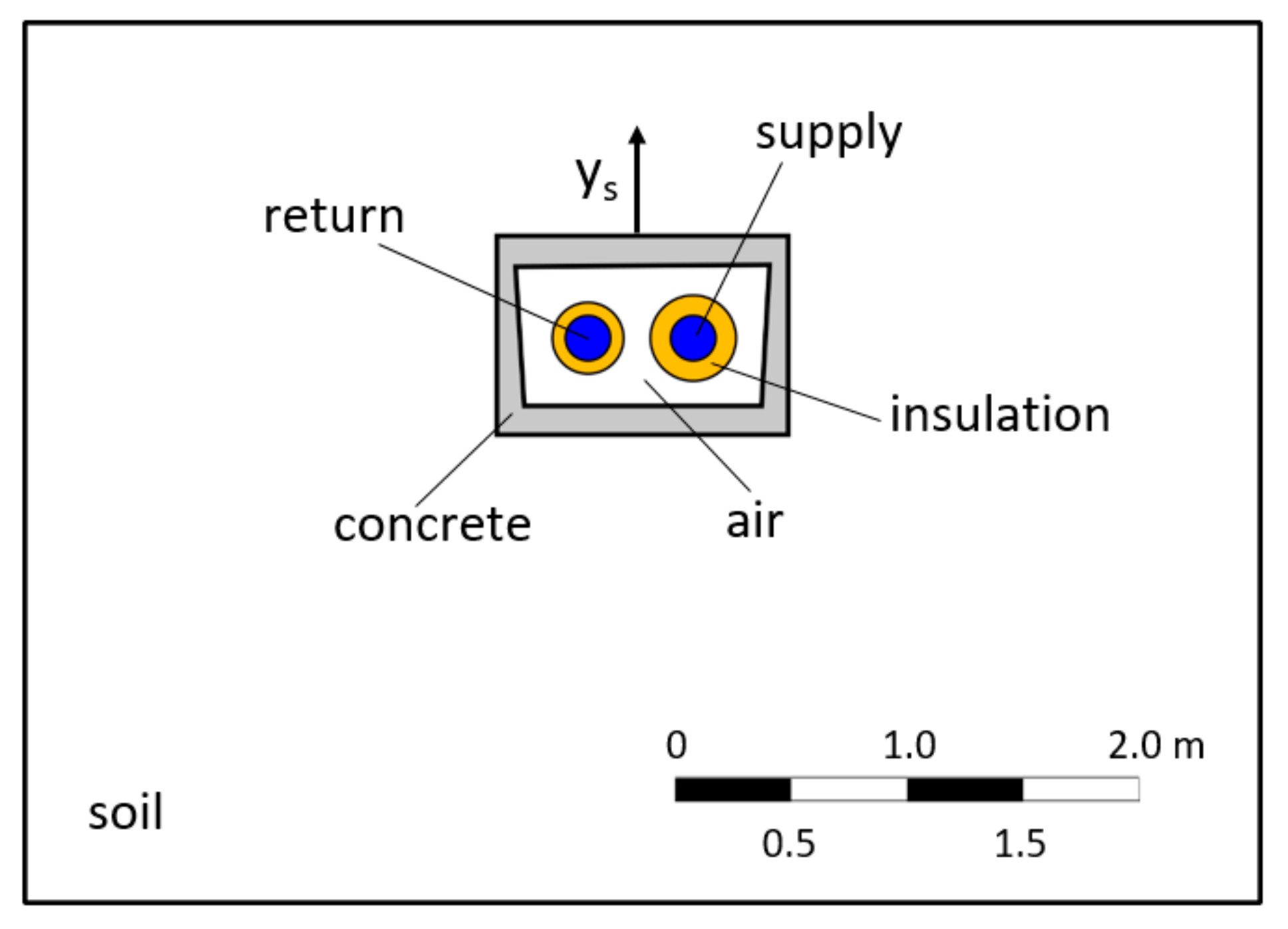
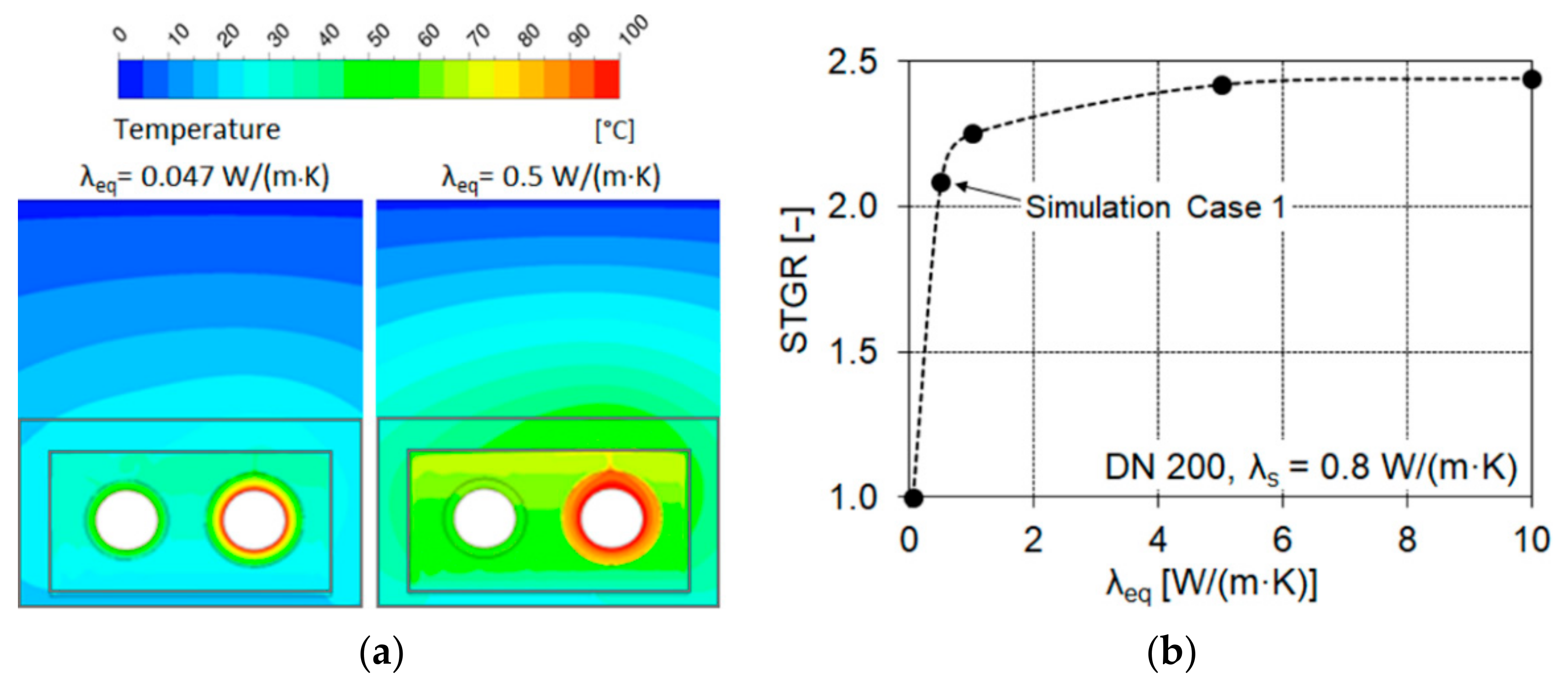

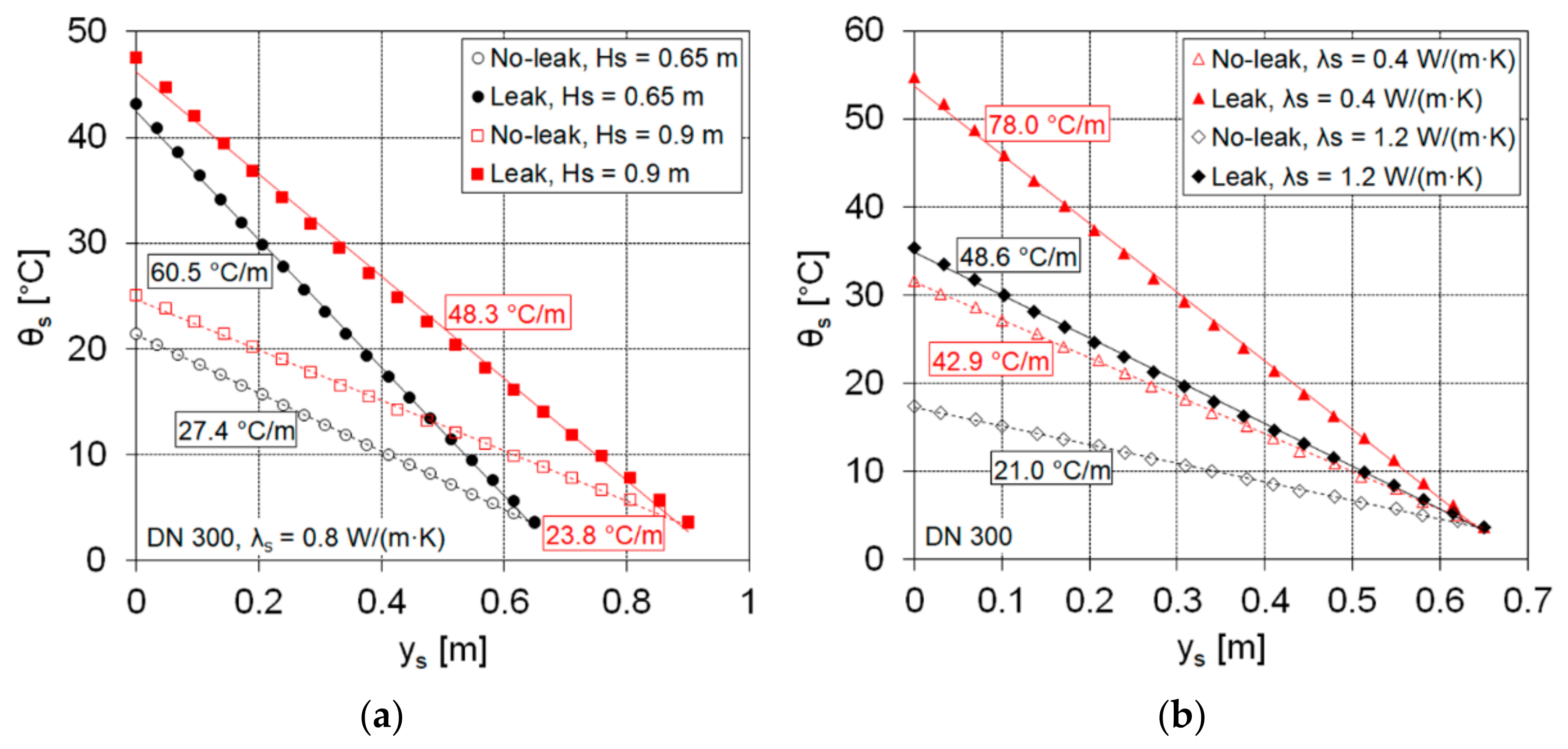
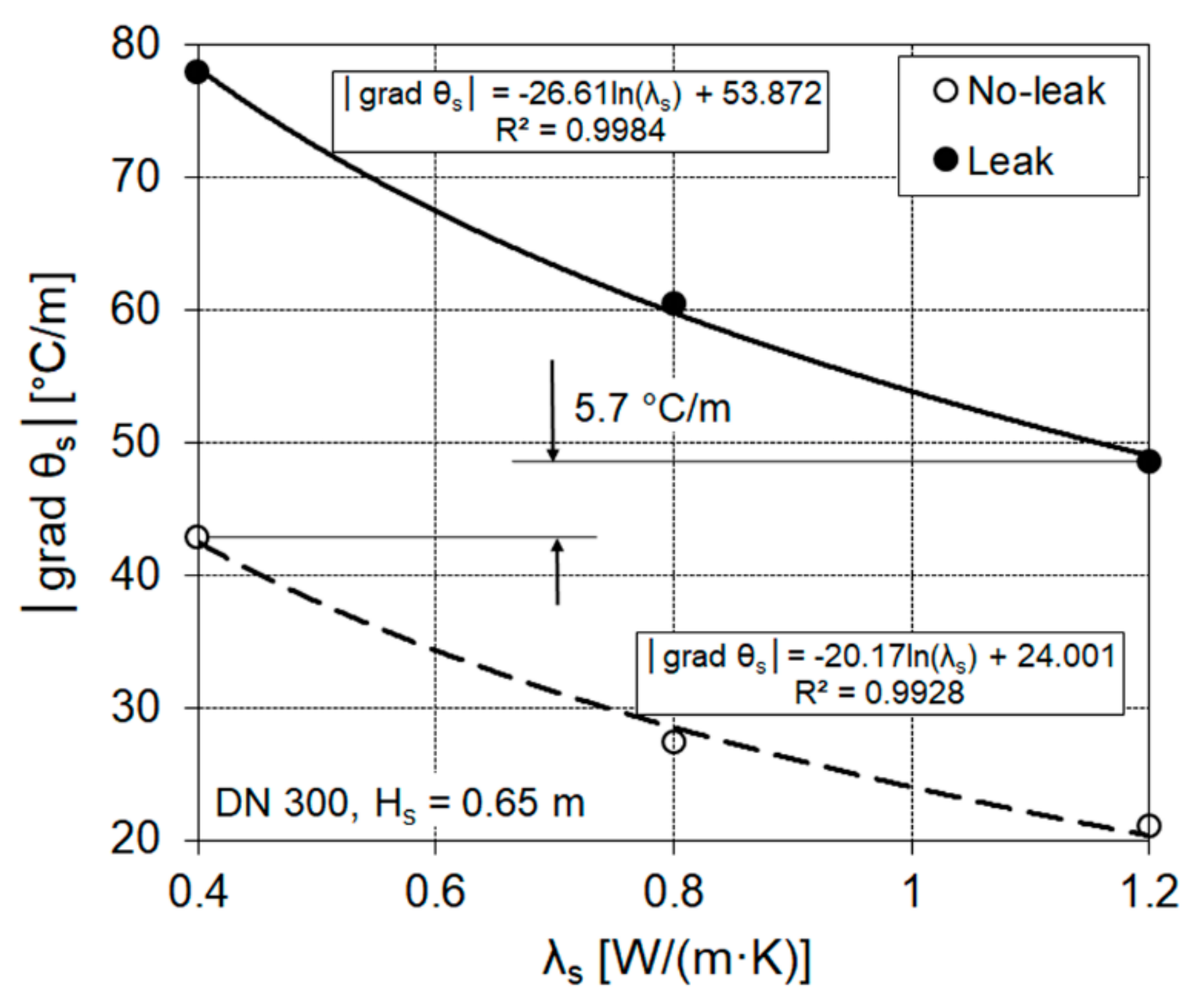
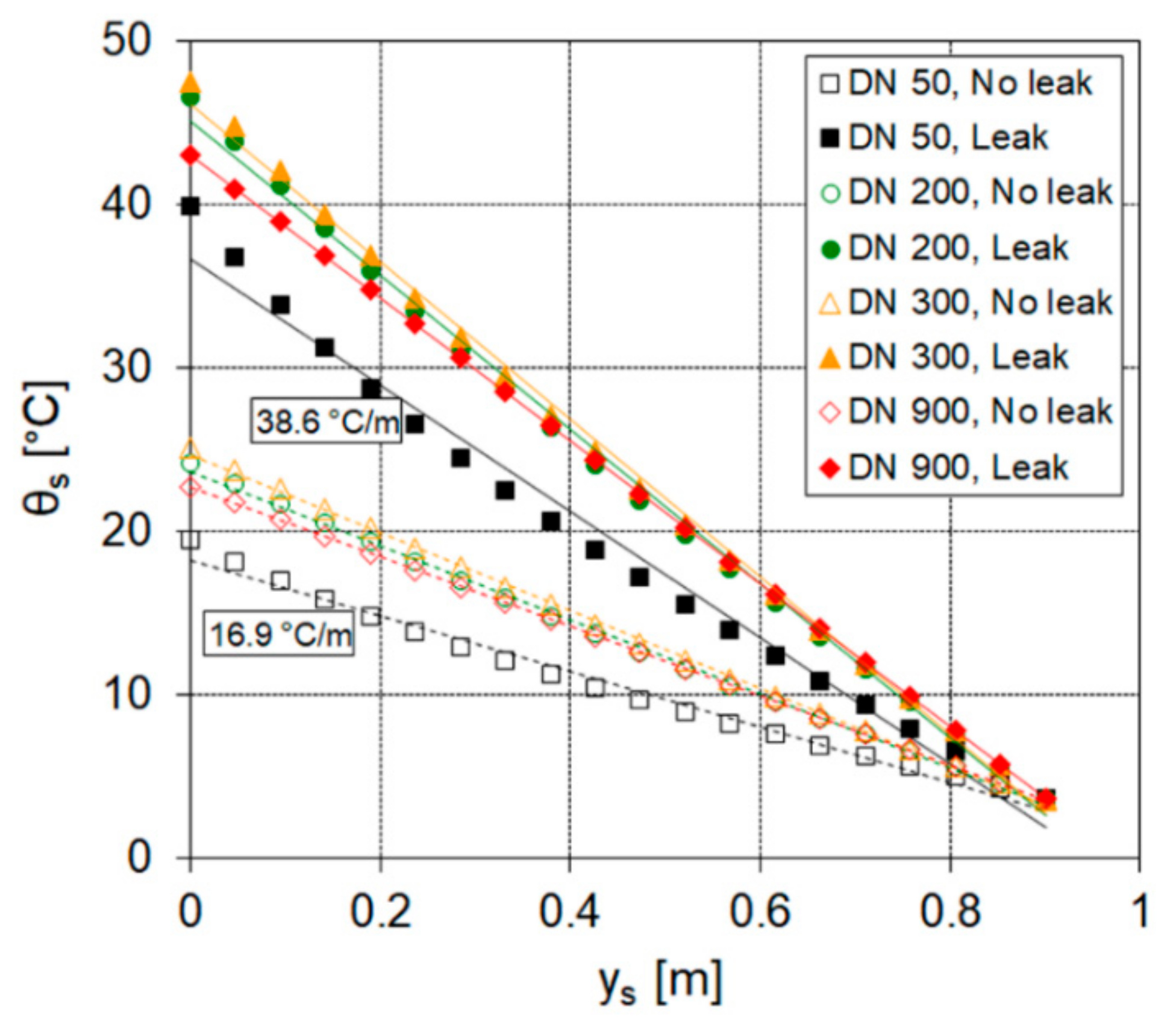
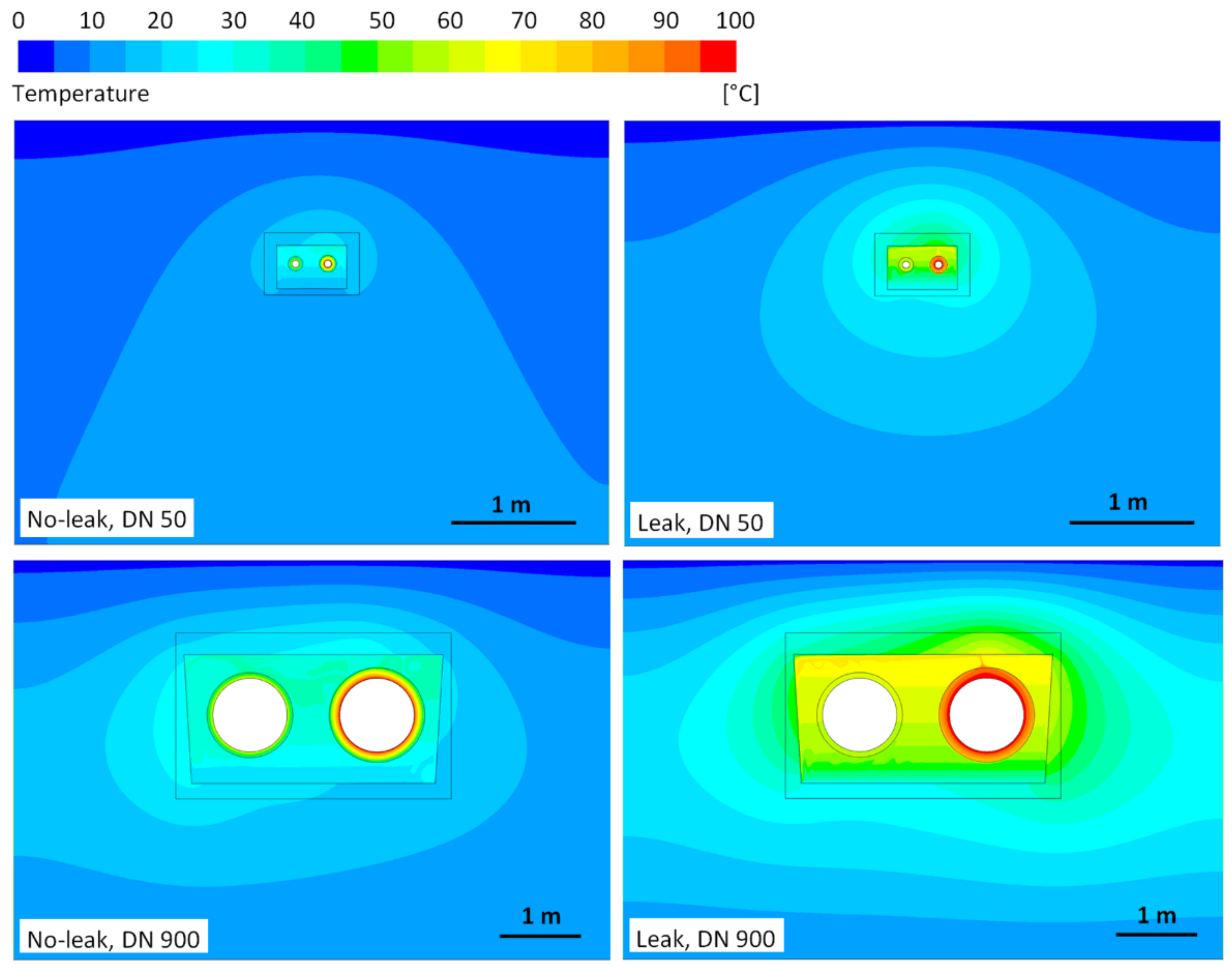
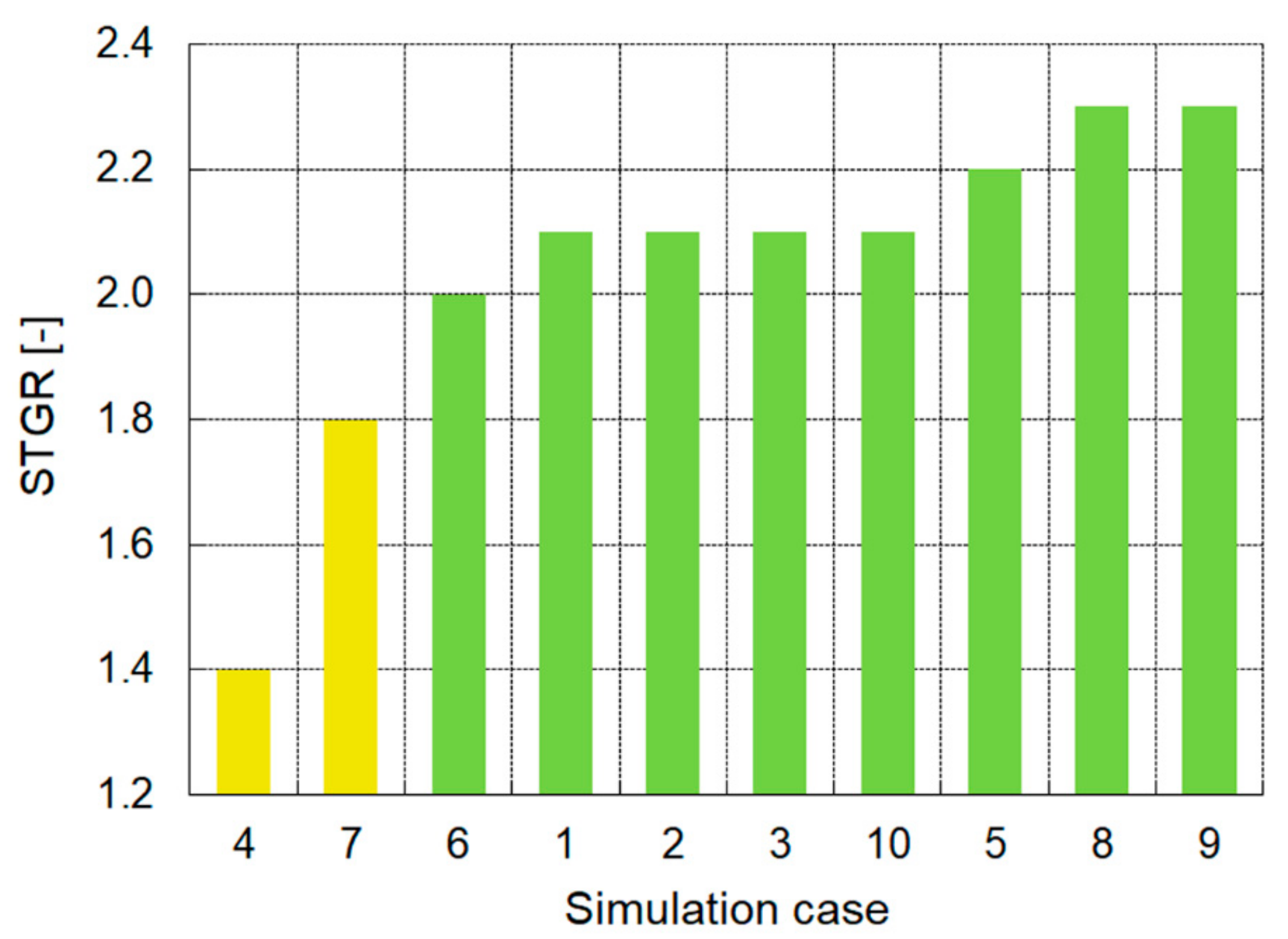
| Simulation Case | 1 | 2 | 3 | 4 | 5 | 6 | 7 | 8 | 9 | 10 |
|---|---|---|---|---|---|---|---|---|---|---|
| Variable | ||||||||||
| h, W/(m2·K) | ‒ | 11.3 | ‒ | ‒ | ‒ | ‒ | ‒ | ‒ | ‒ | |
| Supply leak only | ‒ | ‒ | Yes | ‒ | ‒ | ‒ | ‒ | ‒ | ‒ | ‒ |
| Return leak only | ‒ | ‒ | ‒ | Yes | ‒ | ‒ | ‒ | ‒ | ‒ | ‒ |
| Hs, m | 0.9 | 0.9 | 0.9 | 0.9 | 0.65 | 0.9 | 0.65 | 0.65 | 0.9 | 0.9 |
| λs, W/(m·K) | 0.8 | 0.8 | 0.8 | 0.8 | 0.8 | 0.8 | 0.4 | 1.2 | 0.8 | 0.8 |
| DN, mm | 200 | 200 | 200 | 200 | 300 | 300 | 300 | 300 | 50 | 900 |
Publisher’s Note: MDPI stays neutral with regard to jurisdictional claims in published maps and institutional affiliations. |
© 2021 by the authors. Licensee MDPI, Basel, Switzerland. This article is an open access article distributed under the terms and conditions of the Creative Commons Attribution (CC BY) license (https://creativecommons.org/licenses/by/4.0/).
Share and Cite
Perpar, M.; Rek, Z. The Ability of a Soil Temperature Gradient-Based Methodology to Detect Leaks from Pipelines in Buried District Heating Channels. Energies 2021, 14, 5712. https://doi.org/10.3390/en14185712
Perpar M, Rek Z. The Ability of a Soil Temperature Gradient-Based Methodology to Detect Leaks from Pipelines in Buried District Heating Channels. Energies. 2021; 14(18):5712. https://doi.org/10.3390/en14185712
Chicago/Turabian StylePerpar, Matjaž, and Zlatko Rek. 2021. "The Ability of a Soil Temperature Gradient-Based Methodology to Detect Leaks from Pipelines in Buried District Heating Channels" Energies 14, no. 18: 5712. https://doi.org/10.3390/en14185712
APA StylePerpar, M., & Rek, Z. (2021). The Ability of a Soil Temperature Gradient-Based Methodology to Detect Leaks from Pipelines in Buried District Heating Channels. Energies, 14(18), 5712. https://doi.org/10.3390/en14185712






